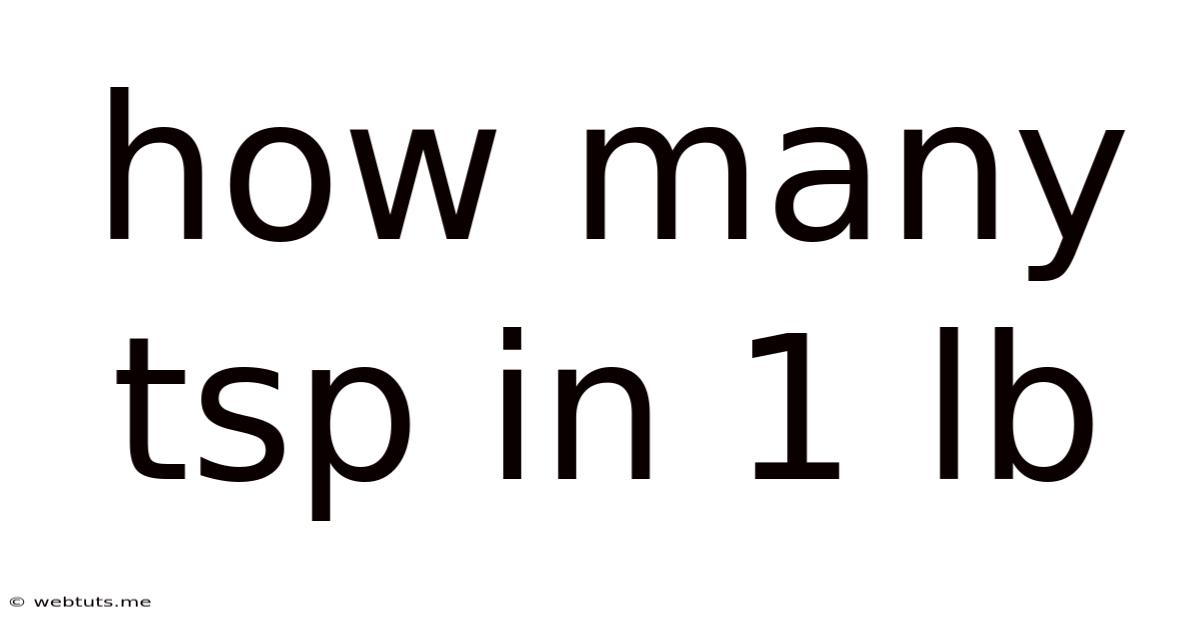How Many Tsp In 1 Lb
Webtuts
May 10, 2025 · 4 min read

Table of Contents
How Many Teaspoons in 1 Pound? A Comprehensive Guide to Unit Conversions
Understanding unit conversions is crucial in various aspects of life, from baking and cooking to scientific research and engineering. One common conversion that often causes confusion is determining the number of teaspoons in a pound. This comprehensive guide will delve deep into this conversion, exploring the intricacies involved and offering practical examples to solidify your understanding.
Understanding the Units: Teaspoons and Pounds
Before jumping into the conversion, let's clarify the units involved:
Teaspoon (tsp):
A teaspoon is a unit of volume commonly used in cooking and baking recipes. It's a small unit, representing a relatively small amount of an ingredient. The exact volume of a teaspoon can vary slightly depending on the measuring spoon used, but it's generally accepted as approximately 4.93 ml (milliliters).
Pound (lb):
A pound is a unit of mass or weight, commonly used in the Imperial and US customary systems of measurement. It's a significantly larger unit than a teaspoon, representing a considerably greater quantity of a substance. One pound is equal to 16 ounces (oz).
The Challenge of Direct Conversion: Why it's not straightforward
The difficulty in directly converting teaspoons to pounds lies in the fundamental difference between the units: volume (teaspoons) versus mass (pounds). You can't directly convert volume to mass without knowing the density of the substance you're measuring. The density is the mass per unit volume. For example, a pound of feathers will occupy a much larger volume than a pound of lead, even though both weigh the same.
This means there's no single, universally applicable answer to "how many teaspoons are in a pound?". The answer depends entirely on what substance you're measuring.
Factors Affecting the Conversion
Several factors significantly influence the conversion from pounds to teaspoons:
- Density: As mentioned, density is the key factor. Denser substances will have fewer teaspoons per pound, while less dense substances will have more.
- Substance: Different substances have vastly different densities. For instance, water has a density of approximately 1 g/ml, while oil has a slightly lower density. Flour, sugar, and other baking ingredients have even lower densities and varying densities of their own.
- Temperature: Temperature can affect the density of a substance. Generally, substances become less dense as temperature increases.
- Packing: How tightly a substance is packed also affects its overall volume. For example, loosely packed flour will occupy more volume than tightly packed flour, even if both weigh a pound.
Calculating the Conversion: A Step-by-Step Approach
To illustrate the conversion process, let's consider an example using water, a commonly used substance with a relatively well-known density. We'll assume the density of water is approximately 1 gram per milliliter (g/ml).
Step 1: Convert pounds to grams:
- 1 pound (lb) = 453.592 grams (g)
Step 2: Convert grams to milliliters (using the density of water):
- Since the density of water is approximately 1 g/ml, 453.592 grams of water equals 453.592 milliliters (ml).
Step 3: Convert milliliters to teaspoons:
- 1 teaspoon (tsp) ≈ 4.93 ml
- 453.592 ml / 4.93 ml/tsp ≈ 91.99 teaspoons
Therefore, approximately 92 teaspoons are in 1 pound of water.
Important Note: This calculation is only valid for water. For other substances, you need to know their density to perform an accurate conversion.
Practical Examples and Applications
Let's explore how this knowledge applies in different scenarios:
Baking and Cooking:
Baking recipes often require precise measurements. Understanding the relationship between pounds and teaspoons helps bakers convert recipes from weight-based measurements (pounds) to volume-based measurements (teaspoons), especially when dealing with ingredients like flour, sugar, and butter. Remember that the conversion will vary for each ingredient due to differences in density.
Scientific Research:
In scientific research, particularly in chemistry and materials science, accurate unit conversions are critical. Converting between mass and volume is essential when dealing with solutions, reactions, and material properties. Understanding the principles outlined here ensures precise experimental measurements and data analysis.
Engineering and Design:
In engineering, precise measurements are vital in construction, design, and manufacturing. Understanding how to convert between different units of measurement is crucial in many aspects of engineering calculations.
The Importance of Using Appropriate Measuring Tools
Accurate conversions rely on accurate measurements. Always use appropriate measuring tools for both weight (a kitchen scale for pounds) and volume (a set of measuring spoons for teaspoons). Avoid relying solely on estimations, as even slight inaccuracies can significantly affect the outcome, especially in baking or scientific experiments.
Conclusion: Precision and Context Matter
There isn't a single answer to "how many teaspoons are in a pound?". The conversion depends heavily on the substance's density, temperature, and packing. This guide demonstrates the importance of understanding the principles of unit conversion and the critical role of density in accurately converting between volume and mass. Remember to always account for the specific substance and conditions when performing such conversions to ensure precision and accuracy in your measurements. Using appropriate tools and understanding these nuances are crucial for achieving accurate results in any field that requires precise measurements.
Latest Posts
Latest Posts
-
How Tall Is 43 Inches In Feet
May 10, 2025
-
2 Out Of 7 Is What Percent
May 10, 2025
-
1 Ampere Is Equal To How Many Watts
May 10, 2025
-
How Many More Days Until March 31st
May 10, 2025
-
How Many Inches Is 27 Centimeters
May 10, 2025
Related Post
Thank you for visiting our website which covers about How Many Tsp In 1 Lb . We hope the information provided has been useful to you. Feel free to contact us if you have any questions or need further assistance. See you next time and don't miss to bookmark.